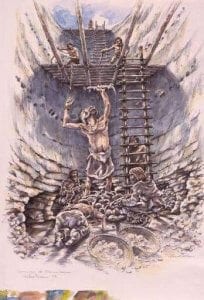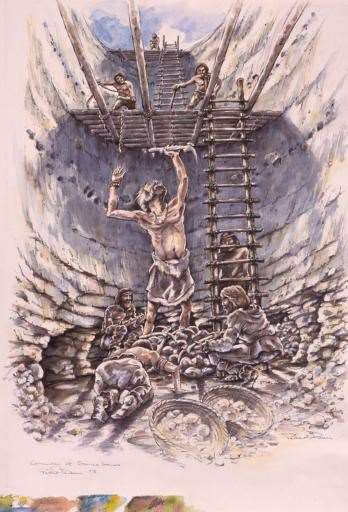Grimes Graves Lynford – Grime’s Graves Thetford Norfolk – Prehistoric Flint Mine
Grimes Graves Norfolk is based at Weeting, Lynford near Thetford and Brandon. Grimes Graves Plan is HERE. The mysterious lunar-like landscape of Grime’s Graves is the legacy of hundreds of years of activity by Neolithic flint miners. From about 4,500 years ago – around the time many of the stones at Stonehenge were first raised – flint miners dug over 400 pits here to extract the fine quality, jet-black flint from which they fashioned tools, weapons and ceremonial objects. Today Grime’s Graves is one of only ten known prehistoric flint mines in England. Grimes Graves is the only Neolithic flint mine open to the public in the UK. This grassy lunar landscape near Thetford of 400 pits was first named Grim’s Graves by the Anglo-Saxons. It was not until one of them was excavated in 1870, that it became apparent and they were identified as flint mines dug over 5,000 years ago. A small exhibition area illustrates the history of this fascinating historicak site. Visitors can descend 9 metres (30 ft) by ladder into one excavated shaft to see the jet-black flint an experience in itself. Set amid the distinctive Breckland heath landscape, Grime’s Graves is also a Site of Special Scientific Interest and a habitat for rare plants and fauna and makes a great day for family visits.
Prices and opening Times for Grime’s Graces
Grimes Graves PRICES – With and without a donation – Member Free and Free – Adult £7.60 and £6.90 – Child (5-17 years) £5.10 and £4.60 – Concession tool-tip £6.90 and £6.20 – Family (2 adults, up to 3 children) £19.70 and £17.90 – Family (1 adult, up to 3 children) £12.10 and £11.00.

Grimes Grimes for The History of Flint mining and rituals
Significance of Grime’s Graves Lynford
Grime’s Graves Norfolk is the only known late Neolithic flint mine in England, and was first used some 4,500 years ago. It was the first archaeological site in the UK to be recognised as a Neolithic flint mine, in 1868–70.[1] It is currently the most studied site of its type. PREHISTORIC FLINT MINES – Grime’s Graves is one of only ten known flint mines in England.[2] There are two other sites in Scotland and a small number in Ireland. Considering there are about 70 causewayed enclosures, nearly 540 long barrows, over 100 mortuary enclosures, 14 bank barrows and more than 40 long mounds known in the UK, flint mines are some of the rarest Neolithic monuments in the country. Download a Plan of Grimes Graves HERE
Late Neolithic tools from Grime’s Graves – These late Neolithic tools from Grime’s Graves include oblique arrowheads (left), a discoidal knife (top) and a scraper (bottom). Many piercing tools (right) were also found, which may have been used for working animal skins. FLINT EXTRACTION – The ‘Gathering Time’ project,[3] which has critically analysed and remodelled the chronology of the early Neolithic period, has demonstrated that flint mines are some of the earliest (if not the earliest) sites created in the Neolithic landscape.
Flint mining was therefore one of the first activities carried out by the incipient Neolithic communities. It may even have been one of the principal motivations underpinning the colonisation of south-eastern Britain – a quest for new and exotic types of stone. The extraction of flint was clearly a pivotal part of the creation of Neolithic communities and how they defined their identities before the more tangible monuments, such as long barrows and causewayed enclosures, were built. Read more…
THE MESOLITHIC PERIOD – GRIMES GRAVES NORFOLK
Although the first mines at Grime’s Graves were dug about 4,500 years ago, the site has evidence of human activity over some 8,000–10,000 years. During the Mesolithic period (about 9500–4000 BC) hunter-gatherers inhabited a densely wooded landscape in this area, foraging for seasonally available foods and resources. At Grime’s Graves, however, evidence of Mesolithic hunter-gatherer activity is found only in two possible hearths from a campsite and a number of flint tools.
THE NEOLITHIC PERIOD
The Neolithic period (about 4000–2300 BC) saw significant changes, both socially and technologically. Farming was introduced by migrants from the Continent about 4100 BC, along with pottery and new types of stone artefact. In about 4000 BC the first flint mines – one of the earliest types of Neolithic site – in England were dug on the South Downs. Soon afterwards, new types of structure such as causewayed enclosures, barrows and chambered tombs were being built. About 2650 BC, during the late Neolithic period, flint mining began at Grime’s Graves. This was about the same time that the first standing stones were being erected at Stonehenge and Avebury, and is also contemporary with the building of Silbury Hill. The period also saw new burial customs appearing, with a move away from communal to individual burials. Trade networks were extensive, and the fine black flint from Grime’s Graves was exchanged or traded over long distances. At Grime’s Graves, the miners dug shafts up to 13 metres deep to where the best flint lay, and worked in subterranean galleries at the base of each shaft, prising out the flint using picks made from antlers. Although the earthworks visible today represent 433 mines and pits, excavations and recent geophysical surveys suggest that the mines covered a much greater area.
RITUALS IN THE MINES – GRIMES GRAVES NORFOLK
aAt Grimes Graves Norfolk – Artefacts that may be deliberate offerings or evidence of ceremonial activities have been found in pits at Grime’s Graves. These imply that the process of flint mining in some shafts followed ritualised practices. Such activities may have been commonplace to the miners, for whom ritual would have been a part of everyday life. In 1971 two highly decorated Grooved Ware pots were discovered on a raised chalk platform at the base of a shaft. Pit 15 produced seven antler picks on another platform, and many mines contained chalk carvings of ‘cups’, balls, phalli and other objects. In a gallery leading from Greenwell’s Pit a dog skeleton, which had been carefully buried, was discovered. Hearths were found on many shaft floors. These had not been used for lighting or cooking, but instead may have had ritual functions.
Even after they had been abandoned, the shafts were a focus for special events. Fires were lit periodically, and offerings of animal remains and occasionally human bones, such as the skull in Pit 1, were placed in the shaft fills. These deposits may have been part of renewal rituals. READ MORE……..
Covid 19 measures are now relaxing and we hope to see you soon.
Mention you found us on Visit Breckland.
No Records Found
Sorry, no records were found. Please adjust your search criteria and try again.
Google Map Not Loaded
Sorry, unable to load Google Maps API.
Find Us:
Weeting
Norfolk
IP26 5DE
